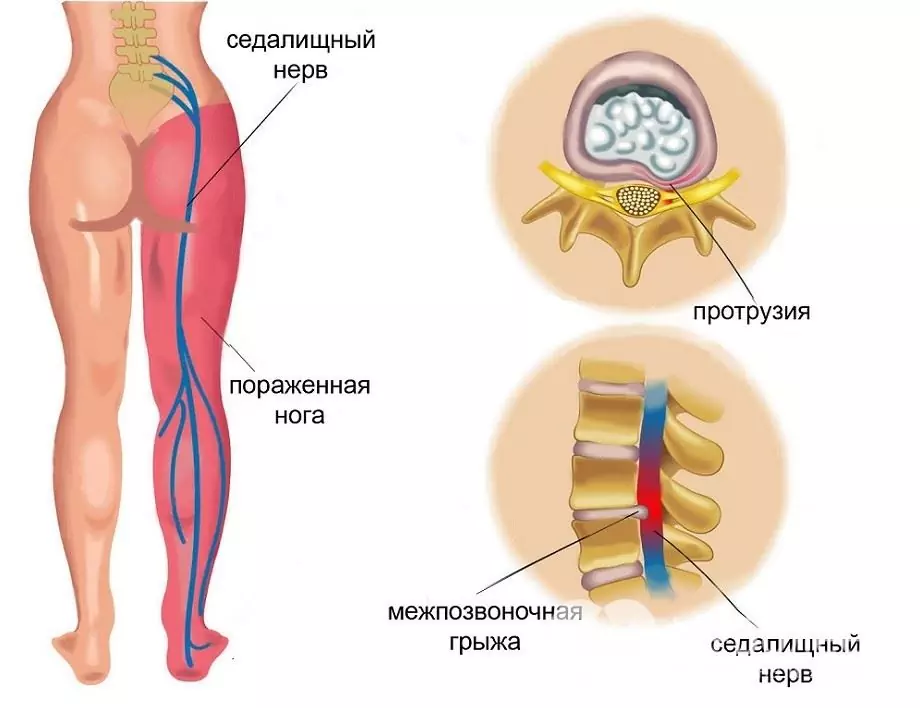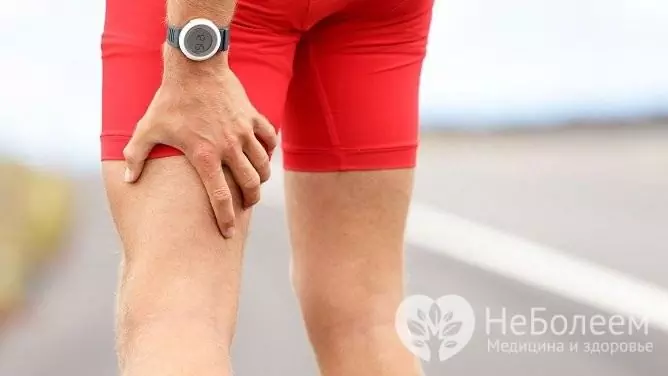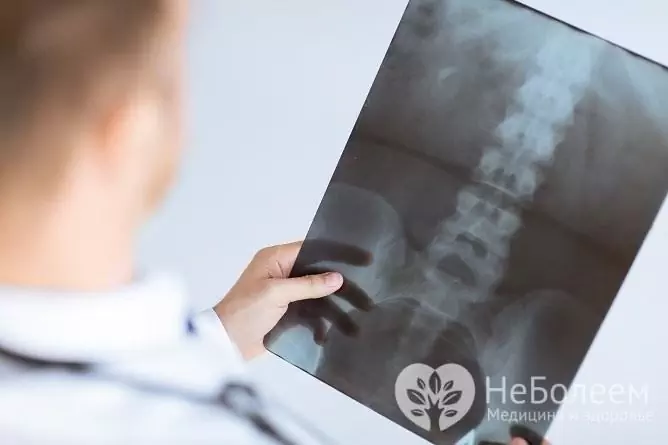- Author Rachel Wainwright [email protected].
- Public 2023-12-15 07:39.
- Last modified 2025-11-02 20:14.
Inflammation of the sciatic nerve
The content of the article:
- Causes of sciatic nerve inflammation
- Sciatic nerve inflammation symptoms
- Diagnostics
- Treatment of sciatic nerve inflammation
- Exercises for inflammation of the sciatic nerve
- Potential consequences and complications
- Forecast
- Prevention
Inflammation of the sciatic nerve (sciatic nerve neuralgia, lumbosacral radiculitis, sciatica) is one of the most common neurological diseases associated with damage to the sciatic nerve (n. Ischiadicus) and clinically manifested by burning pain in the back of the thigh, weakness of the knee joint, skin sensitivity of the skin of the lower leg and foot.
The disease is usually one-sided. Bilateral lesions of the sciatic nerve are rare. Mostly people aged 40-60 suffer from sciatica, the incidence rate is 25-30 cases per 100,000 population.
Inflammation of the sciatic nerve can permanently reduce the patient's ability to work, and in severe cases even causes disability. Therefore, this pathology is considered by vertebrologists and neurologists not only as a medical problem, but also as a socially significant problem.

Signs of sciatic nerve inflammation
Causes of sciatic nerve inflammation
The causes of sciatic nerve inflammation are varied. These include:
- hypothermia of the lumbar region;
- lifting weights;
- herpes infection;
- osteochondrosis;
- gout;
- pelvic injuries;
- herniated disc;
- spondylosis;
- spinal stenosis;
- malignant or benign tumors of the spine;
- malignant or benign tumors of the pelvic organs;
- piriformis syndrome;
- diabetes;
- urological and gynecological diseases;
- pregnancy and abnormal childbirth;
- Reiter's syndrome;
- Lyme disease;
- blood vessel thrombosis;
- poisoning with heavy metals (arsenic, mercury, lead).
Infectious diseases, for example, HIV infection, measles, rubella, scarlet fever, tuberculosis, can also cause inflammation of the sciatic nerve.
Sciatic nerve inflammation symptoms
The main symptom of sciatic nerve inflammation is intense pain that spreads along the affected nerve trunk and is called sciatica. It is localized in the gluteal region and back of the thigh, extending to the lower leg and foot to the very toes. The nature of this pain is described by patients as a "blow with a dagger", the pain is shooting or burning. It is often so pronounced that patients assume a forced position and cannot move independently. The pain syndrome is combined with skin sensitivity disorders in the affected lower limb.

Inflammation of the sciatic nerve manifests itself as sciatica - pain in the buttock and back of the thigh
Objective examination determines the difficult flexion of the leg in the knee joint, which is explained by paresis of the semitendinosus, semimembranosus and biceps muscles. Against this background, the tone of the quadriceps muscle of the thigh begins to prevail, and the leg is fixed in a position extended at the knee joint. Therefore, a typical symptom of sciatic nerve inflammation is walking with a straightened leg.
During a neurological examination, a decrease or absence of Achilles and plantar tendon reflexes, paresis of the muscles of the foot are noted. Long-term illness can cause these muscles to atrophy.
Disorders of pain sensitivity with inflammation of the sciatic nerve cover the outer and back surfaces of the lower leg, as well as the foot. Weakening of the musculo-articular feeling is noted in the ankle and interphalangeal joints, and in the area of the external ankle, vibration sensitivity disappears or sharply weakens.
Other signs of sciatic nerve inflammation are:
- soreness at the point of exit of the sciatic nerve to the thigh;
- soreness in the Valle and Gar points;
- a positive Bonnet symptom (a symptom of tension), which consists in the occurrence of a sharp shooting pain in the patient when trying to passively move the leg bent at the knee and hip joint to the side in the supine position;
- a positive symptom of Lasegue (sharp pain that occurs at a certain stage of slowly raising a straightened leg in a supine position).
In some cases, inflammation of the sciatic nerve is accompanied by vasomotor and trophic disorders. This is manifested by a cold snap of the skin of the foot, its cyanosis, impaired sweating in the plantar region (hyperhidrosis, anhidrosis).
Diagnostics
The diagnosis of sciatic nerve inflammation, due to the pronounced clinical picture of the disease, does not cause difficulties. It is much more difficult to establish the cause underlying the development of the pathological process.
At the time of examining the patient, the neuropathologist pays special attention to the features of the pain syndrome, zones of reflex loss, a decrease in muscle strength and a violation of skin sensitivity.

To clarify the diagnosis of inflammation of the sciatic nerve, X-ray of the lumbosacral spine allows
In the diagnosis of sciatic nerve inflammation, instrumental diagnostic methods are used:
- electroneurography;
- electromyography;
- ultrasound examination of the pelvic organs and hip joints;
- X-ray of the lumbosacral spine;
- computed or magnetic resonance imaging of the pelvic organs and hip joints.
Treatment of sciatic nerve inflammation
Bed rest is recommended, and patients with sciatic nerve inflammation should be placed on a hard surface. The best position is on the stomach with a small pillow under the chest. If necessary, the patient can be covered with a warm blanket. Heating pads and warming compresses should not be used, since heat increases blood flow to the lesion site, as a result of which soft tissue swelling increases, compression of the sciatic nerve increases, respectively, the pain becomes more intense.
Medical treatment of sciatic nerve inflammation is carried out only as directed by a neuropathologist. The therapy regimen includes:
- Non-steroidal anti-inflammatory drugs. These drugs have a pronounced anti-inflammatory and analgesic effect. To prevent the possible development of side effects, you should not increase the dosage recommended by your doctor.
- Central-acting analgesics. They are used to relieve intense pain syndrome, in a short course, as they can cause the formation of mental dependence in the patient.
- Corticosteroids. They have a powerful anti-inflammatory and anti-edema effect. In severe cases, when other drugs are ineffective, drugs of this group can be injected into the epidural space, which contributes to the rapid improvement of the patient's condition.
- Antidepressants. Reduce the severity of fear and anxiety, calm the patient, and normalize sleep.
- Vitamins. Vitamin complexes have a beneficial effect on the functions of the nervous system, contribute to the restoration of damaged nerve fibers.

Treatment of inflammation of the sciatic nerve is carried out using a whole range of drugs
Also, in the treatment of sciatic nerve inflammation, ointments are widely used that have either an anti-inflammatory effect (Voltaren, Diclofenac, Nurofen), or a local irritant effect (Finalgon, Apizatron).
At the stage of remission, they resort to physiotherapeutic methods of influence, use electro- and phonophoresis of drugs, UHF therapy, magnetic and laser therapy, acupuncture, paraffin applications.
In case of ineffectiveness of conservative therapy, the issue of surgical treatment of sciatica is considered. The choice of the method of surgical intervention depends on what kind of condition caused the sciatic nerve damage.
Exercises for inflammation of the sciatic nerve
After the acute process subsides, patients are recommended regular exercise therapy. Exercise with inflammation of the sciatic nerve accelerates the rehabilitation process, and is also an effective prevention of relapse.
Physiotherapy exercises should be started under the guidance of an instructor. Exercises should not cause muscle overexertion, discomfort, the appearance or intensification of pain. The intensity of the loads should increase smoothly as the patient's muscle strength increases. Physiotherapy can be supplemented with other types of physical activity, such as swimming, walking or cycling.

Physical therapy helps you recover from sciatic nerve inflammation
The main goal of physiotherapy exercises for inflammation of the sciatic nerve is to increase muscle tone, improve their blood supply, and relieve inflammation. In addition, regular physical activity helps to normalize body weight, allows you to form a so-called muscle corset - to strengthen the muscles that support the spinal column and prevent the nerve roots from being pinched.
Exercises for inflammation of the sciatic nerve are aimed at working out different muscle groups and, above all, the buttocks and legs. The complex may include the following exercises:
- Starting position: lying on your back on a firm surface. Raise your legs and, bending at the knee joints, pull them to your chest. Hold this position for 30 seconds. Return to starting position. Repeat 10-12 times. If the exercise is difficult, you can support the buttocks with your hands.
- Starting position: lying on its side. Pull your legs to your chest, pulling the socks, and then straighten. The exercise should be performed 10-12 times at a fast pace.
- Starting position: lying on your stomach, legs together, arms extended forward. Raise the upper body up, coming off the floor. At the same time, the legs remain motionless. Hold this position for a few seconds and smoothly return to the starting position. Perform the exercise 5-6 times. As the muscles strengthen, the number of repetitions gradually increases.
- Starting position: sitting on a chair, back straight, arms behind the head, legs crossed. Perform turns of the body to the right and left. 10 turns should be made in each direction.
- Starting position: Kneeling on the floor, arms raised above your head. Lean forward, trying to reach the floor with your palms, and then return to the starting position. You must do the exercise 15 times.
- Starting position: sitting on the floor, legs extended forward, arms raised to shoulder level and spread apart. With springy movements, take your arms back and return to the starting position. Repeat the exercise 5-8 times.
- Starting position: lying on your back, legs apart, arms behind your head. Slowly raise your legs without lifting your shoulder blades from the floor. At the maximum point, the legs should be fixed for a few seconds, after which they smoothly return to their original position. Repeat the exercise 5-10 times.
- Starting position: standing, feet shoulder-width apart. Put your right hand on the waist, and extend the left over your head. Perform 10 bends to the right. After that, change the position of the hands and perform the same number of bends to the left.
Potential consequences and complications
Frequent or long-term inflammation of the sciatic nerve has a negative effect on the blood supply and trophism of the muscles of the affected limb, as well as some internal organs. The redistribution of physical activity caused by the forced position of the affected limb leads to a dysfunction of the entire musculoskeletal system and negatively affects the body as a whole.
Sciatica can cause a number of complications:
- dryness and thinning of the skin on the affected limb;
- muscle atrophy, as a result of which the leg from the side of the lesion "dries up", that is, it loses its volume;
- thinning and increased fragility of nails;
- decreased muscle strength;
- violation of the mechanics of movements in the knee and ankle joints, which leads to changes in gait, increased fatigue;
- paresis or paralysis of the muscles of the affected leg.
Complications of inflammation of the sciatic nerve from the internal organs are retention or incontinence of stool, loss of control over urination, a sharp decrease in libido, erectile dysfunction.
Forecast
With timely and adequate treatment, the prognosis is favorable. If conservative therapy is ineffective, indications for surgical intervention may arise.
Prevention
Regularly carried out preventive measures allow more than 80% to reduce the risk of developing primary inflammation of the sciatic nerve, as well as relapses of the disease. These activities include:
- regular physical activity;
- correct lifting of weights (from a squat position with a straight back);
- the formation of correct posture;
- avoiding hypothermia of the lumbar and pelvic region;
- maintaining a normal body weight.
YouTube video related to the article:

Elena Minkina Doctor anesthesiologist-resuscitator About the author
Education: graduated from the Tashkent State Medical Institute, specializing in general medicine in 1991. Repeatedly passed refresher courses.
Work experience: anesthesiologist-resuscitator of the city maternity complex, resuscitator of the hemodialysis department.
The information is generalized and provided for informational purposes only. At the first sign of illness, see your doctor. Self-medication is hazardous to health!






